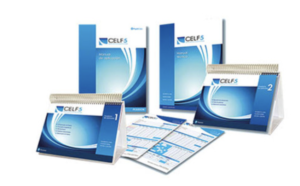Giving the Clinical Evaluation of Language Fundamentals- 5th Edition (CELF-5)
The Clinical Evaluation of Language Fundamentals-5th Edition (CELF-5) is a standardized measure that is administered to evaluate the expressive and receptive language skills of clients in comparison to other children of the same chronological age. It is for children ages 5-21 years.

When it comes to expressive and receptive language evaluations, the CELF-5 is one of the most widely used. One of my favorite features of the CELF-5 is that there is an online version through Q Global. If administering the online version, you will need a second camera for the following directions subtest, but everything is just as easy as being in person.
One other thing to note- SLPs who administer the CELF-5 should be familiar with the client’s background and linguistic differences such as dialectal variations or English as a second language as these variations can negatively impact the client’s scores. There are directions in the manual on how to administer and score for these clients.
CELF-5 Areas of Assessment
The CELF-5 includes the following subtests for:
ALL ages:
- Word Classes
- Following Directions
- Formulated Sentences
- Recalling Sentences
- Understanding Spoken Paragraphs
- Pragmatics Profile
5-8 years of age:
- Sentence Comprehension
- Linguistic Concepts
- Word Structure
9-21 years of age:
- Word Definitions
- Sentence Assembly
- Semantic Relationships
Scoring the CELF-5
The evaluator completes all sections of the assessment that are required for the client’s age. Directions are given for each subtest as well as the basal and ceiling (where to start and end). The evaluator then calculates the client’s correct responses for each subtest and uses the manual to obtain a scaled score.
The subtest scaled scores are combined and transferred to composite quotients, which gives a more reliable assessment of the child’s ability of overall language features. The composite quotients are as follows:
- Core Language: Measures overall language abilities
- Receptive Language: Measures listening and auditory comprehension abilities
- Expressive Language: Measures expressive language abilities
- Language Content: Measures vocabulary and concept development
- Language Structure: Measures interpretation and production of word and sentence structure.
These composite quotients correlate to a rating of above average, average, borderline, low, or very low.

Borderline Language Skills
Children with borderline language skills may demonstrate some difficulties in expressive and receptive language, but this may be easily overlooked in the classroom setting. Their expressive language may be characterized by less descriptive content, difficulty using a wide variety of vocabulary, and occasional grammatical errors. They may struggle with organizing thoughts and expressing complex ideas. In terms of receptive language, they may have difficulty understanding longer or more complex instructions or conversations but can follow simple, routine tasks easily.
Low-Level Language Skills
Children with low language skills may exhibit more significant challenges in both expressive and receptive language. Expressively, they may have a limited vocabulary, struggle with word finding, and produce shorter and simpler sentences. Their grammar and sentence structure may be noticeably affected. Receptively, they may struggle to understand complex or new instructions, follow long conversations, or comprehend age-appropriate vocabulary. They may require repetition or more explicit and concrete language input to participate. These children will most likely struggle in the general classroom setting.
Very Low-Level Language Skills
Children with very low language skills may experience severe challenges in the general classroom setting. They may be able to engage in simple, everyday conversations with teachers and peers but struggle with understanding and expressing complex or new information. Behavioral issues may emerge as the child tries to avoid difficult tasks.
For more info on report writing, check out these resources- ⬇️
Blog post: Write a Great Speech and Language Report
FREE course: Write Speech and Language Reports Like a Boss
Blog post: Giving the Functional Communication Profile
